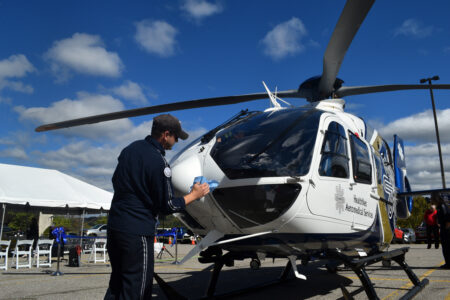WVU Medicine Wheeling Hospital Helicopter Lifts Emergency Medicine to New Heights

photo by: Derek Redd
Pilot Troy McMahan polishes the nose of the new helicopter that is part of the fleet at WVU Medicine Wheeling Hospital.
WHEELING — WVU Medicine Wheeling Hospital introduced a brand-new medical helicopter to the fleet Monday afternoon — and the emphasis was on “brand-new.”
The new Airbus H135 helicopter that sat in the hospital parking lot Monday had just eight hours of flight time on its log, and still had that “new copter” smell. The $8.5 million aircraft represented WVU Medicine’s continued devotion to state-of-the-art health care in West Virginia, officials said. The helicopter also is an investment in shaving down minutes in a field — emergency medicine — where a few minutes can mean life or death.
The helicopter is a collaboration between HealthNet Aeromedical Services, WVU Medicine and Air Methods Corporation. It replaces the current Moundsville-based helicopter that will leave the HealthNet Fleet.
HealthNet itself is a collaboration between WVU Medicine, Vandalia Health and Marshall Health Network, allowing the three health systems to utilize a critical-care transport system that can help the entire state.
WVU Medicine North Region President Douglass Harrison said the addition of this helicopter is a major move.
“Seconds matter, especially in trauma care,” Harrison said, “and to have the best service available and best helicopter available to serve our patients, I think that speaks volumes to the investments we’re making into local health care.”
This new helicopter saves time in several ways, according to HealthNet President and CEO Clinton Burley and Cyndi Carter, Airbus EMS market specialist for North America. It has a bigger fuel capacity and a bigger payload capability, so it can take care of more people at once and travel farther on one tank. It has a maximum flight range of 342 miles and a maximum flight endurance of 3 hours, 36 minutes.
It also is equipped with a Helionix avionics suite, a flight system specifically engineered by helicopter pilots for helicopters, which is a big safety boost. It reduces the workload and fatigue for pilots, allows the pilots to focus more on what’s in front of them than looking at the instruments, and allows the helicopter to operate in a wider variety of weather conditions.
It’s also equipped with state-of-the-art emergency medicine tools, essentially making it a flying intensive care unit.
“The staff they have are trained and dedicated to make sure that patient gets to their destination in a very timely manner, but alive,” Harrison said.
Such an aircraft is crucial for hospitals in a state like West Virginia, full of remote areas and mountains to navigate. A full fleet of helicopters – Burley said that by the end of 2025, half the fleet will be less than six months old – will get more patients to more hospitals in a shorter time.
“You think about rural communities where someone is in an ATV accident,” Burley said. “Our teams are arriving with blood, with plasma, with ventilators. They’re arriving with everything you would see in a high-level intensive care unit.”
Harrison said that this new helicopter, and the overall fleet, wouldn’t be capable without the collaboration between those three major West Virginia health systems. WVU Medicine, Marshall Health and Vandalia Health working together for the good of their patients and avoiding the territorialism that can come with competition will save lives.
“We’re here to help the citizens of West Virginia,” Harrison said.




